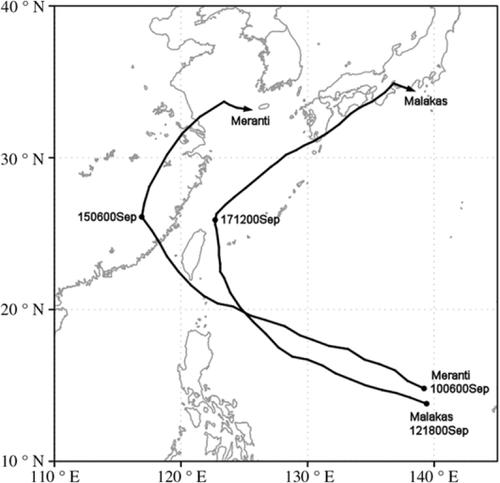当前位置:
X-MOL 学术
›
Meteorol. Appl.
›
论文详情
Our official English website, www.x-mol.net, welcomes your feedback! (Note: you will need to create a separate account there.)
Influence of varying time scale flows on tropical cyclone track changes
Meteorological Applications ( IF 2.7 ) Pub Date : 2020-03-10 , DOI: 10.1002/met.1893 Xiaoyu Chen 1, 2 , Chao Li 1, 2 , Jingjing Duan 3 , Lu Cao 2
Meteorological Applications ( IF 2.7 ) Pub Date : 2020-03-10 , DOI: 10.1002/met.1893 Xiaoyu Chen 1, 2 , Chao Li 1, 2 , Jingjing Duan 3 , Lu Cao 2
Affiliation

|
It is often difficult to predict tropical cyclone (TC) tracks for the case of binary or even multiple TCs. To investigate this issue, two TCs over the western North Pacific basin in September 2016, Meranti and Malakas, were explored in this study. The two TCs formed close to each other, and their tracks were similar at an early stage but then deflected northward over different regions. The results indicate that the Meranti track change may be due to the asymmetric high‐frequency flows induced by topography, while the Malakas track change is attributed to the formation and strengthening of low‐frequency southerlies. It was found that the formation and evolution of low‐frequency monsoon circulation is the main cause for the emergence of the low‐frequency flows, and the process is accompanied by the enhancement and movement of low‐frequency positive vorticity. Therefore, based on the diagnostic results using the low‐frequency vorticity budget equation, it is shown that the low‐frequency vorticity advection and convergence induced by the low‐frequency flows play varying roles in the development of low‐frequency positive vorticity. More noteworthy is that the high‐frequency positive vorticity of TCs can trigger the enhancement of low‐frequency positive vorticity through nonlinear interactions, which have rarely been discussed in previous studies. It can be concluded that the interactions between high‐ and low‐frequency flows and vorticity may affect the development and evolution of the TCs at different time scales, finally leading to TC track deflection.
中文翻译:

时间尺度变化对热带气旋径迹变化的影响
对于二元甚至多个TC,通常很难预测热带气旋(TC)的轨迹。为了调查这一问题,本研究探索了2016年9月北太平洋西部盆地的两个热带气旋,即Meranti和Malakas。这两个热带气旋相互靠近,并且在早期它们的轨迹相似,但随后在不同区域向北偏转。结果表明,Meranti径迹的变化可能是由于地形引起的不对称高频流动,而Malakas径迹的变化归因于低频南风的形成和加强。研究发现,低频季风环流的形成和演化是低频季风出现的主要原因,这个过程伴随着低频正涡的增强和运动。因此,根据使用低频涡度预算方程的诊断结果,可以看出,低频流动引起的低频涡流对流和收敛在低频正涡的发展中起着不同的作用。更值得注意的是,TCs的高频正涡旋可通过非线性相互作用触发低频正涡旋的增强,这在以前的研究中很少讨论。可以得出结论,高频流和低频流与涡度之间的相互作用可能会影响TC在不同时间尺度上的发展和演变,最终导致TC磁道偏转。根据低频涡旋预算方程的诊断结果,表明低频涡旋对流和由低频流动引起的收敛在低频正涡旋的发展中起着不同的作用。更值得注意的是,TCs的高频正涡旋可通过非线性相互作用触发低频正涡旋的增强,这在以前的研究中很少讨论。可以得出结论,高频流和低频流与涡度之间的相互作用可能会影响TC在不同时间尺度上的发展和演变,最终导致TC磁道偏转。根据低频涡旋预算方程的诊断结果,表明低频涡旋对流和由低频流动引起的收敛在低频正涡旋的发展中起着不同的作用。更值得注意的是,TCs的高频正涡旋可通过非线性相互作用触发低频正涡旋的增强,这在以前的研究中很少讨论。可以得出结论,高频流和低频流与涡度之间的相互作用可能会影响TC在不同时间尺度上的发展和演变,最终导致TC磁道偏转。结果表明,低频流动引起的低频涡旋对流和收敛在低频正涡旋的发展中起着不同的作用。更值得注意的是,TCs的高频正涡旋可通过非线性相互作用触发低频正涡旋的增强,这在以前的研究中很少讨论。可以得出结论,高频流和低频流与涡度之间的相互作用可能会影响TC在不同时间尺度上的发展和演变,最终导致TC磁道偏转。结果表明,低频流动引起的低频涡旋对流和收敛在低频正涡旋的发展中起着不同的作用。更值得注意的是,TCs的高频正涡旋可通过非线性相互作用触发低频正涡旋的增强,这在以前的研究中很少讨论。可以得出结论,高频和低频流动与涡度之间的相互作用可能会影响TC在不同时间尺度上的发展和演变,最终导致TC磁道偏转。在以前的研究中很少讨论过。可以得出结论,高频流和低频流与涡度之间的相互作用可能会影响TC在不同时间尺度上的发展和演变,最终导致TC磁道偏转。在以前的研究中很少讨论过。可以得出结论,高频流和低频流与涡度之间的相互作用可能会影响TC在不同时间尺度上的发展和演变,最终导致TC磁道偏转。
更新日期:2020-03-10
中文翻译:

时间尺度变化对热带气旋径迹变化的影响
对于二元甚至多个TC,通常很难预测热带气旋(TC)的轨迹。为了调查这一问题,本研究探索了2016年9月北太平洋西部盆地的两个热带气旋,即Meranti和Malakas。这两个热带气旋相互靠近,并且在早期它们的轨迹相似,但随后在不同区域向北偏转。结果表明,Meranti径迹的变化可能是由于地形引起的不对称高频流动,而Malakas径迹的变化归因于低频南风的形成和加强。研究发现,低频季风环流的形成和演化是低频季风出现的主要原因,这个过程伴随着低频正涡的增强和运动。因此,根据使用低频涡度预算方程的诊断结果,可以看出,低频流动引起的低频涡流对流和收敛在低频正涡的发展中起着不同的作用。更值得注意的是,TCs的高频正涡旋可通过非线性相互作用触发低频正涡旋的增强,这在以前的研究中很少讨论。可以得出结论,高频流和低频流与涡度之间的相互作用可能会影响TC在不同时间尺度上的发展和演变,最终导致TC磁道偏转。根据低频涡旋预算方程的诊断结果,表明低频涡旋对流和由低频流动引起的收敛在低频正涡旋的发展中起着不同的作用。更值得注意的是,TCs的高频正涡旋可通过非线性相互作用触发低频正涡旋的增强,这在以前的研究中很少讨论。可以得出结论,高频流和低频流与涡度之间的相互作用可能会影响TC在不同时间尺度上的发展和演变,最终导致TC磁道偏转。根据低频涡旋预算方程的诊断结果,表明低频涡旋对流和由低频流动引起的收敛在低频正涡旋的发展中起着不同的作用。更值得注意的是,TCs的高频正涡旋可通过非线性相互作用触发低频正涡旋的增强,这在以前的研究中很少讨论。可以得出结论,高频流和低频流与涡度之间的相互作用可能会影响TC在不同时间尺度上的发展和演变,最终导致TC磁道偏转。结果表明,低频流动引起的低频涡旋对流和收敛在低频正涡旋的发展中起着不同的作用。更值得注意的是,TCs的高频正涡旋可通过非线性相互作用触发低频正涡旋的增强,这在以前的研究中很少讨论。可以得出结论,高频流和低频流与涡度之间的相互作用可能会影响TC在不同时间尺度上的发展和演变,最终导致TC磁道偏转。结果表明,低频流动引起的低频涡旋对流和收敛在低频正涡旋的发展中起着不同的作用。更值得注意的是,TCs的高频正涡旋可通过非线性相互作用触发低频正涡旋的增强,这在以前的研究中很少讨论。可以得出结论,高频和低频流动与涡度之间的相互作用可能会影响TC在不同时间尺度上的发展和演变,最终导致TC磁道偏转。在以前的研究中很少讨论过。可以得出结论,高频流和低频流与涡度之间的相互作用可能会影响TC在不同时间尺度上的发展和演变,最终导致TC磁道偏转。在以前的研究中很少讨论过。可以得出结论,高频流和低频流与涡度之间的相互作用可能会影响TC在不同时间尺度上的发展和演变,最终导致TC磁道偏转。

























 京公网安备 11010802027423号
京公网安备 11010802027423号